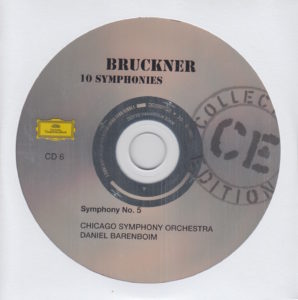Today starts a new leg in my 144-day journey.
And not a moment too soon.
I was so done with Symphony 5…and so really looking forward to starting No. 6.
And so I am.
 This morning’s conductor of Anton Bruckner’s Symphony No. 6 in A Major (WAB 106) is Argentine-born pianist and conductor Daniel Barenboim (1942-), whom I will see in person at Carnegie Hall in January.
This morning’s conductor of Anton Bruckner’s Symphony No. 6 in A Major (WAB 106) is Argentine-born pianist and conductor Daniel Barenboim (1942-), whom I will see in person at Carnegie Hall in January.
For this project, I first listened in earnest to Maestro Barenboim on Day 1 (Symphony No. 1).
Then again on Day 17 (Symphony No. 2).
Then again on Day 33 (Symphony No. 3).
 Then again on Day 49 (Symphony No. 4).
Then again on Day 49 (Symphony No. 4).
And, most recently, on Day 65 (Symphony No. 5).
One of the reasons why I enjoy these projects I undertake from time to time (aside from the fact that I love music and movies and literature) is to learn as much as I can about the subject matter.
To that end, I quote the beginning of the Wikipedia article on Symphony No. 6 in A Major:
Symphony No. 6 in A major (WAB 106) by Austrian composer Anton Bruckner (1824–1896) is a work in four movements composed between September 24, 1879 and September 3, 1881 and dedicated to his landlord, Dr. Anton van Ölzelt-Newin. Though it possesses many characteristic features of a Bruckner symphony, it differs the most from the rest of his symphonic repertory. Redlich went so far as to cite the lack of hallmarks of Bruckner’s symphonic compositional style in the Sixth Symphony for the somewhat bewildered reaction of supporters and critics alike.
According to Robert Simpson, though not commonly performed and often thought of as the ugly duckling of Bruckner’s symphonic body of work, the Sixth Symphony nonetheless makes an immediate impression of rich and individual expressiveness: “Its themes are exceptionally beautiful, its harmony has moments of both boldness and subtlety, its instrumentation is the most imaginative he [Bruckner] had yet achieved, and it possesses a mastery of classical form that might even have impressed Brahms.”
Researching…researching…researching…
I noticed on the Wiki page the following tidbit:
Premiere
Date: 26 February 1899
Location: Graz
Conductor: Gustav Mahler
Performers: Vienna Philharmonic
The first time Bruckner’s Sixth was performed in public, Gustav Mahler conducted it.
See? I wouldn’t have known that had I not looked it up.
But, apparently, Mahler wasn’t a saint with Bruckner’s composition. According to the section Revisions and Editions on Wiki:
The Fifth, Sixth, and Seventh Symphonies represent Bruckner’s period of confidence as a composer, and apart from his unfinished Ninth Symphony, they are the only symphonies in which Bruckner did not make extensive revisions. In fact, the Sixth Symphony is the only Bruckner symphony that was exempt from any revisions from the composer himself. However, Gustav Mahler made substantial changes to the score before he conducted the 1899 premiere of the symphony in its entirety, revisions unsanctioned by Bruckner as they were posthumous.
Researching…researching…researching…
From the section Critical and Cultural Reception on Wiki:
Harsh critical reception of the Sixth Symphony, as well as his entire body of work, can also be attributed to critical reception of Bruckner as a person. He was a devout Catholic whose religious fervor often had a negative effect on those he encountered. One of his pupils, Franz Schalk, commented that it was the age of moral and spiritual liberalism…but also in which he [Bruckner] intruded…with his medieval, monasterial concept of humankind and life.
Fascinating.
“Ugly duckling” and “bewildered reaction” and “harsh critical reception” are not exactly high praise.
But I’m up for the challenge.
Bring it on.
 Especially since Robert Simpson, author of The Essence of Bruckner, has this to say about Bruckner’s Sixth:
Especially since Robert Simpson, author of The Essence of Bruckner, has this to say about Bruckner’s Sixth:
The Fifth, Sixth, and Seventh Symphonies represent Bruckner’s period of greatest confidence as a composer; apart from the unfinished Ninth, they are the only ones in which he never made wholesale revisions…The A major symphony, which Bruckner thought his boldest, was not given its premiere until 1899 (three years after his death)…It has always been neglected, and I have never been able to understand why, for it has consistently struck me (apart from one or two short passages in the Finale) as among his most beautiful and original works; his own high opinion of it seems thoroughly justified.
But first, the objective aspects of this recording.
Bruckner’s Symphony No. 6 in A Major (WAB 106) composed 1879-1881
Daniel Barenboim conducts
Barenboim used the 1881 version
Chicago Symphony Orchestra plays
The symphony clocks in at 57:28
This was recorded at Medinah Temple in Chicago in December of 1978
Barenboim was 36 when he conducted it
Bruckner was 57 when he finished composing it
This recording was released on the Deutsche Grammophon (DG) label
Bruckner wrote his symphonies in four parts. The time breakdown of this one (Symphony No. 6 in A Major, 1881 version), from this particular conductor (Barenboim) and this particular orchestra (Chicago Symphony Orchestra) is as follows:
I: Majestoso…………………………………………………………………………………………………….16:35
II: Adagio. Sehr feierlich (Very solemnly)……………………………………………………….18:13
III: Scherzo. Nicht schnell (Not fast) — Trio. Langsam (Slowly)………………………8:48
IV: Finale. Bewegt, doch nicht zu schnell (With motion, but not too fast)……14:32
Total running time: 57:28
Now, the subjective aspects.
My Rating:
Recording quality: 5
Overall musicianship: 5
CD liner notes: 4 (short essay in three languages)
How does this make me feel: 5
The opening notes of Movement I gave me hope for something more that was new and different.
My hope was realized.
This is new and different.
Movement I (Majestoso) features a sound that’s like a cross between a movie soundtrack (Lawrence of Arabia, perhaps) and a Beatles song with Paul McCartney’s bouncing/walking bass line.
I don’t know enough about stringed orchestral instruments to know what makes the low notes. Viola? Bass? Cello?
Whatever it is, the “bass line” (as it would be called in a rock song; and probably is in this Classical composition, too) is very distinctive. In fact, if I didn’t know this was a Classical piece, I’d swear it was a rock song. Not because it has a 4/4 time signature or screaming guitar solos or anything like that Rather, because there is, at times, a distinct “walking” bass line similar to one in a rock song with a really fine bassist. (I only mentioned Paul McCartney because he’s a really fine bassist.) If you listen closely, you can hear the bass line, often descending in counterpoint to the other instruments, in the background.
That sounds crazy, I know. Bruckner is not the Beatles.
But I was surprised and delighted by the bass line of Movement I and, mentally, compared it to that found in a good rock song. I had never heard that kind of bass work in any piece of Classical music before. Maybe I never listened that closely. But maybe nobody ever wrote like Bruckner.
The entire Majestoso has a dramatic quality to it. As I mentioned, it reminds me of a soundtrack to a big Hollywood production from the 1950s or 1960s. Lawrence of Arabia comes to mind first (I’ll post a link to that theme tomorrow. You’ll see what I mean.) Or maybe even something like Star Wars from the 1970s.
And Titanic from 1999. The violins playing dee dee dee dee dee – dee dee dee dee dee in the first :40 or so sound like what James Horner is playing just before the big ship hits the iceberg. (Or was it just after?)
But the theme to Lawrence of Arabia is definitely there.
Movement III (Scherzo) is a sweeping, grand, yet playful, piece of music. What gets me really existed is 5:42 onward. There is an intriguing, clever melody at 5:50 to 5:57 that I had been waiting to hear in all of Symphony No. 5 – and never did.
The final minute (13:37-14:39) of Movement IV (Finale) is energizing, bold, and dramatic, the perfect way to bring Bruckner’s Sixth to a close.
I wasn’t thrilled with Symphony No. 5.
I am thrilled with Symphony No. 6.
“Huzzah!”
